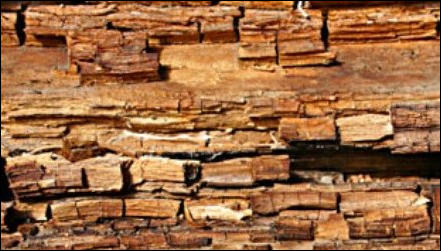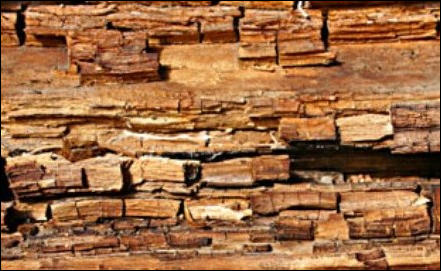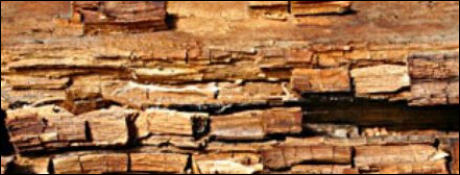Timber Treatment | Woodworm | Dry Rot | Hastings | Ashford | Tunbridge Wells | Canterbury | Rye | Maidstone
TimberGuard Timber Preservation
DRY ROT
TimberGuard Timber Preservation specialist treatment for dry rot in Hastings,
Tunbridge Wells, Canterbury, Rye and Maidstone.
What is Dry Rot?
Dry Rot (Serpula Lacrymans) is a fungal decay of
timber that can cause major damage to the
structure of buildings.
It most commonly occurs in areas where there is
dampness combined with a lack of ventilation,
creating an ideal environment for the fungus to
grow.
Damp wooden floors or roof spaces where there is dampness due to damaged or blocked gutters or
broken tiles are ideal environments for dry rot to develop and once it has appeared it will continue to
grow within the timbers and weaken the structure of that part of the property.

Dry Rot develops from a microscopic spore which, in the presence of moisture, sends out fine white
strands of fungal mycelium which looks rather like fine cotton wool, These strands, known as
hyphae, spread across the surface of the wood, often over great distances, in a search for more
damp wood to colonise. The strands also carry moisture to the distant, drier, timbers which in turn
become susceptible to rot.
This spread can even cross brickwork which, combined with its rapid
rate of growth (up to 30m to 40 mm per week) means that a property
can experience extensive damage in a very short timescale.
As the fungus grows, it draws moisture from the timber which loses weight and shrinks into the
characteristic dry rot cuboidal pieces.
The final stage in its growth is a fleshy white or pale grey fruiting body covered in rusty red spores
which are discharged in their millions, producing the red dust which is another characteristic of the
condition.
If left untreated this is possibly the worst kind of timber decay because the structure of a building
can be rapidly compromised creating an often dangerous situation. Instances of dry rot should be
inspected by an expert timber infestation surveyor.
TimberGuard Timber Preservation specialists provide you with a full free of charge survey and
report and a quotation for any necessary repair and treatment work at a cost competitive
price plus the assurance of a 20 year guarantee after the work has been completed.



01233 367155 01892 322165
07312 257516
Timber Treatment | Woodworm | Dry Rot | Hastings | Ashford | Tunbridge Wells | Canterbury | Rye | Maidstone
TimberGuard Timber Preservation
01233 367155 01892 322165
07312 257516
DRY ROT
TimberGuard Timber Preservation specialist treatment for dry rot in Hastings, Tunbridge Wells, Canterbury,
Rye and Maidstone.
What is Dry Rot?
Dry Rot (Serpula Lacrymans) is a fungal decay of timber that can cause major
damage to the structure of buildings.
It most commonly occurs in areas where there is dampness combined with a
lack of ventilation, creating an ideal environment for the fungus to grow.
Damp wooden floors or roof spaces where there is dampness due to damaged
or blocked gutters or broken tiles are ideal environments for dry rot to develop
and once it has appeared it will continue to grow within the timbers and
weaken the structure of that part of the property.

Dry Rot develops from a microscopic spore which, in the presence of moisture, sends out fine white strands of fungal mycelium
which looks rather like fine cotton wool, These strands, known as hyphae, spread across the surface of the wood, often over
great distances, in a search for more damp wood to colonise. The strands also carry moisture to the distant, drier, timbers which
in turn become susceptible to rot.
This spread can even cross brickwork which, combined with its rapid rate of growth (up to 30m to 40
mm per week) means that a property can experience extensive damage in a very short timescale.
As the fungus grows, it draws moisture from the timber which loses weight and shrinks into the
characteristic dry rot cuboidal pieces.
The final stage in its growth is a fleshy white or pale grey fruiting body covered in rusty red spores which are discharged in their
millions, producing the red dust which is another characteristic of the condition.
If left untreated this is possibly the worst kind of timber decay because the structure of a building can be rapidly
compromised creating an often dangerous situation. Instances of dry rot should be inspected by an expert timber infestation
surveyor.
TimberGuard Timber Preservation specialists provide you with a full free of charge survey and report and a quotation
for any necessary repair and treatment work at a cost competitive price plus the assurance of a 20 year guarantee after
the work has been completed.



TimberGuard Timber Preservation
Timber Treatment | Woodworm | Dry Rot | Hastings
Ashford | Tunbridge Wells | Canterbury | Rye | Maidstone

DRY ROT
TimberGuard Timber Preservation
specialist treatment for dry rot in
Hastings, Tunbridge Wells, Canterbury,
Rye and Maidstone.
What is Dry Rot?
Dry Rot (Serpula Lacrymans) is a fungal decay of
timber that can cause major damage to the
structure of buildings.
It most commonly occurs in areas where there is
dampness combined with a lack of ventilation,
creating an ideal environment for the fungus to
grow.
Damp wooden floors or roof spaces where
there is dampness due to damaged or blocked
gutters or broken tiles are ideal environments
for dry rot to develop and once it has appeared
it will continue to grow within the timbers and
weaken the structure of that part of the
property.
Dry Rot develops from a microscopic spore
which, in the presence of moisture, sends out
fine white strands of fungal mycelium which
looks rather like fine cotton wool, These strands,
known as hyphae, spread across the surface of
the wood, often over great distances, in a search
for more damp wood to colonise. The strands
also carry moisture to the distant, drier, timbers
which in turn become susceptible to rot.
This spread can even cross brickwork which,
combined with its rapid rate of growth (up to
30m to 40 mm per week) means that a property
can experience extensive damage in a very
short timescale.
As the fungus grows, it draws moisture from the
timber which loses weight and shrinks into the
characteristic dry rot cuboidal pieces.
The final stage in its growth is a fleshy white or
pale grey fruiting body covered in rusty red
spores which are discharged in their millions,
producing the red dust which is another
characteristic of the condition.
If left untreated this is possibly the worst kind
of timber decay because the structure of a
building can be rapidly compromised creating
an often dangerous situation. Instances of dry
rot should be inspected by an expert timber
infestation surveyor.
TimberGuard Timber Preservation specialists
provide you with a full free of charge survey
and report and a quotation for any necessary
repair and treatment work at a cost
competitive price plus the assurance of a 20
year guarantee after the work has been
completed.





































